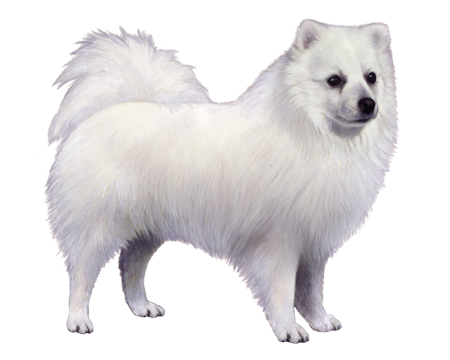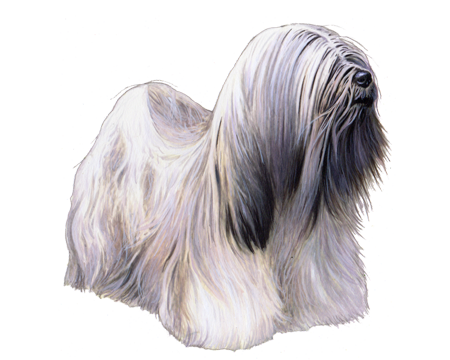
Tibetan Terrier
The Tibetan Terrier is known for being a sensitive, affectionate breed. With a long history as watchdogs, Tibetan Terriers are just as likely to monitor their surroundings as they are to snuggle with their families.
Interested in discovering if your dog is a Tibetan Terrier?
Check out Wisdom Panel's DNA tests.

Tibetan Terrier Traits
General Appearance
The Tibetan Terrier is a medium-sized dog with well-balanced proportions, a powerful build, and effortless gait. They have medium-length, heavily furnished tails that curl up and fall over their backs. Tibetan Terriers also have large eyes and pendant ears.
Coat and Coloring
Tibetan Terriers have double coats with soft, woolly undercoats and profuse, fine—but not silky or woolly—outercoats that may be straight or wavy. While their coats are long, they should not hang to the ground.
Puppies have shorter coats with softer textures than adults. In the show ring, no scissoring, trimming or sculpting of the coats is permitted.
All colors or combinations of colors are acceptable. The most common colors include black, black and white, brindle, gold, sable, and white and black.
Distinctive Physical Traits
One of the Tibetan Terrier’s most unique traits is their large, flat feet. Their feet are round in shape, the pads are thick and strong with abundant hair between the toes and pads, giving Tibetan Terriers snowshoe-like traction. This unique physical attribute helped Tibetan Terriers navigate the snowy, mountainous terrain in their native Tibet.
Tibetan Terrier Temperament
The Tibetan Terrier is a highly intelligent breed. With their owners, these dogs are sensitive, loyal, and devoted, but they’re often cautious or reserved with strangers. Tibetan Terriers are good with children and other pets and appreciate relationships based on cooperation, trust, and respect.
Thanks to their watchdog roots, Tibetan Terriers are alert and want to protect their owners and territories, often barking at signs of perceived danger. Training can help these dogs distinguish between typical household/outdoor sounds and noises that could signal trouble. With training, Tibetan Terriers can be quiet, respectful apartment dogs.


Tibetan Terrier History
The Tibetan Terrier is an ancient breed that, despite its name, is not a terrier at all. The breed hails from Tibet, China where it lived in Buddhist monasteries, serving as watchdogs and companions.
Lamas treasured Tibetan Terriers, keeping them as good luck charms. Often given as gifts, Tibetan Terriers represented a sign of respect or good fortune. Their prized place in Tibetan culture helped the breed earn the nickname “Holy Dogs of Tibet.”
Tibetan Terriers are also agile, surefooted, and powerful jumpers that may have worked as herders, flock guardians, and retrievers, working in extreme climates and difficult terrain.
Tibetan Terrier Care
Nutrition
Feed Tibetan Terriers a high-quality dog food that is appropriate for their life stage (puppy, adult, senior). These dogs are not prone to overeating and will often savor their food, even leaving some behind. It’s still best to portion out their food with a measuring cup and ensure that treats make up no more than 10 percent of their daily calories to avoid overfeeding.
Grooming
Despite their long hair, Tibetan Terriers require minimal grooming. Their coats can withstand the elements, which means this breed
Like all breeds, Tibetan Terriers benefit from a regular dental care routine that includes at-home teeth brushing and professional cleanings.
Exercise
Tibetan Terriers don’t require a lot of exercise, but they appreciate regular walks, games in the backyard, or trips to the dog park. These dogs are also good at “self-exercise” and will play with toys to burn off their energy. Tibetan Terriers also enjoy working alongside their owners and enjoy activities such as agility, rally, and nose work.
These one-time watchdogs appreciate a spot where they can look out the window to survey their surroundings.
Training
Tibetan Terriers have an independent streak and, though they are quick learners, may choose not to follow directions and will shut down if training is repetitive or harsh. Use positive reinforcement and reward-based training to teach Tibetan Terriers basic commands and new tricks. Prioritize a mix of mental and physical stimulation to keep training fresh and engaging.
Socialization is also important to satisfy their curious, outgoing personalities.

Tibetan Terrier Genetic Health Conditions
-
Chondrodystrophy (CDDY) and Intervertebral Disc Disease (IVDD) Risk
Chondrodystrophy (CDDY) is a skeletal disorder characterized by shortened limbs and abnormal early degeneration of the spinal discs, or intervertebral disc disease (IVDD), which predisposes to disc herniation.
-
Primary Lens Luxation
Primary Lens Luxation (PLL) is a condition that can cause the lens of the eye to become loose and eventually displace. The disorder is caused by degeneration of the fibers that hold the lens in place.
-
Progressive Retinal Atrophy Type III
Progressive Retinal Atrophy (PRA) is a disorder that causes the degeneration of the light sensing retina at the back of the eye, resulting in vision loss.
Knowing if your Tibetan Terrier is a carrier or at-risk for these conditions can help you and your veterinarian plan for your pup’s lifelong care. With Wisdom Panel™ Premium, you can get results for over 200 genetic health tests.
Breed Group
Companion
This group consists of dogs typically bred for the specific purpose of human companionship, and many are popular pets because of their gentle nature. They became more common as the concept and luxury of dogs as pets prevailed.
Resources
https://www.akc.org/dog-breeds/tibetan-terrier/
http://images.akc.org/pdf/breeds/standards/TibetanTerrier.pdf
Reviewed July 26, 2020 by Cindy Elston, DVM, MPH



























_Color.png)





















